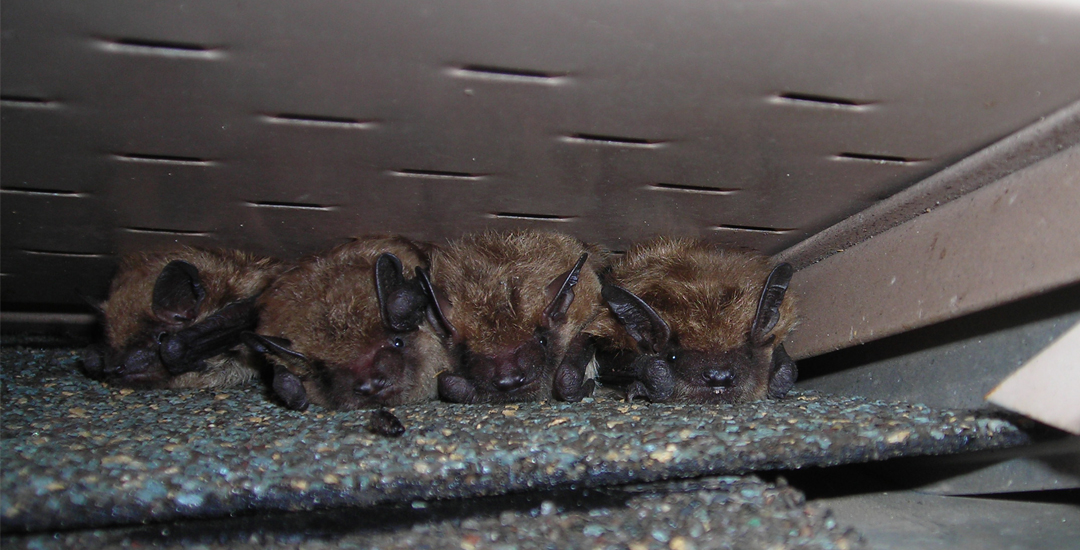BAT REMOVAL PROCESS
Assess and Remove
The key to removing bats from your home is determining their entry points. Bats can enter through small openings and leave very little trace behind. Our expert technicians will identify all the entry points and evict the colony humanely using one-way doors that allow the bats to leave for food but prevent their re-entry.
Clear and Clean
Depending on the size of the colony and how long they’ve been living in the home there could be a large mess to clean up. Our wildlife technicians will thoroughly remove bat guano and disinfect the space to eliminate any harmful contaminants left behind.
Prevent and Protect
Our wildlife technicians complete a full, comprehensive protection plan against any future bat infestations. This includes sealing all the tiny gaps and openings around your home’s roofline to keep bats out.
Bat Removal Hamilton
Of all the wildlife species that call Hamilton home, bats are certainly one of the most polarizing. Bats, and many of the myths surrounding them, can elicit fear in many Hamilton residents, while others marvel at their unique ability to navigate using echolocation and their importance in helping to keep insect populations in check.
No matter where you stand on bats, most homeowners would agree that being woken up in the middle of the night to a bat flying around your bedroom is never fun. When that happens, it is important to have a trusted bat removal specialist on your side to help separate fact from myth and provide you with the information you need to protect your family and pets. Skedaddle has over 30 years of experience humanely removing and excluding bats from Hamilton homes and businesses.
Bats in Hamilton
According to researchers at McMaster University, Hamilton has one of the highest bat populations in Ontario. There are eight species of bats found in the province and all eight of them call Hamilton home. Of the eight, only two bat species are known to roost inside homes and structures, the little brown bat and the big brown bat.
Many species of bats have undergone severe population decline due to white-nose syndrome, a highly contagious disease, first discovered in North America in 2007, that has killed millions of bats across the continent. The little brown bat, once commonly found in the walls and attics of farm houses in communities surrounding Hamilton, is now an endangered species according to Ontario’s Ministry of Environment and Energy. It is believed that the population of little brown bats has declined by over 90%. White nose syndrome is caused by a fungus that spreads in cold, humid conditions where bats overwinter, like underground caves, and kills bats by causing them to awake from hibernation prematurely.
Less affected by white-nose syndrome, the majority of bats taking up residence inside homes in Hamilton today are big brown bats. Compared to little brown bats, it is believed that big brown bat populations have been less impacted by white nose syndrome in large part because they tend to overwinter inside homes and buildings rather than caves. The dryer conditions found in structures prevent the spread of the deadly fungus to bats living inside.
There are methods and techniques for removing bat colonies from your walls and attic that do not involve harming bats. Skedaddle’s team of bat removal specialists have the knowledge and experience to humanely remove bats from your home to protect your family and pets from a potentially dangerous bat encounter. Our partnership with the Hamilton/Burlington Humane Society is one way that our knowledgeable team helps to spread the word in the community about bat conservation and the role humane removal plays in their protection.
How Bats Impact Hamilton Residents
Compared to other mammals found in Hamilton, bats are a relatively common rabies carrier. They can pass the disease to people or pets, like cats and dogs, during their stay inside a home. Each summer, as temperatures rise, bats living inside walls and attics begin to move down wall cavities in search of cooler temperatures. When they do, they become lost and often emerge into the living space of the home putting them into contact with the people inside.
Though bats are not aggressive animals, Hamilton public health officials estimate 100-200 people receive bites from bats each year. Residents bitten by a bat should always have the bat immediately tested for rabies. Public Health Services reported positive rabies tests for bats in the spring of 2021, and again in 2022. The rabid bats were discovered after biting Hamilton residents and in both cases the victims received post-exposure rabies treatments.
Immediate testing of a bat after a bite or scratch is the best way to reduce the spread of the virus. A common way for bats and humans to come into contact with one another is when an individual bat living in the walls or attic of a home emerges into the living space. Due to their small teeth, bat bites have the opportunity to go unnoticed. Immediate removal and cleaning of a bat colony in your Hamilton home is the best way to reduce the chances of your family or pets coming into contact with a potentially rabid bat.
Where Seasonal Cycles Lead Hamilton Bats
Summer is the most common time of year for bats to make their way into the living spaces of homes across Hamilton. Bats are sensitive to temperature change and during a summer heat wave the areas they normally occupy inside a home can become uncomfortable, causing them to move downward in search of cooler temperatures. When they do, it is not unusual for some bats to become lost inside the walls of the home and eventually make their way into the living space. They often emerge into the basement where there tend to be more openings for plumbing, electrical and HVAC. Skedaddle’s team of bat removal specialists have the training and experience needed to remove bats from home and provide you with a game plan to prevent future incidents.
Warm weather also means an abundance of flying insects for bats to consume each night, as they restore the fat stores they lost during their winter hibernation. At dusk you may spot darting overhead in open spaces like Gage Park as they devour thousands of bugs in the sky. You may even see them on a nighttime walk through your neighbourhood as they feast on swarms beneath the glow of the lamp posts.
Bats adapt their habits and behaviour to changing weather and seasonal conditions in Hamilton. During wintertime, flying insects all but disappear so in order to conserve their energy bats will go into hibernation. The perfect hibernation spot is one that offers protection from both the weather and predators and provides fairly consistent temperatures. Underground caves and abandoned mines all fit the bill, but for local bat populations in Hamilton the attics and walls of homes are more common roosting sites. Bats only need a small opening to gain access to a home’s attic or walls. Bat colonies are found in both older homes in Hamilton’s lower city core as well as in fairly newly constructed subdivisions surrounding the city.
What Bats Do When They Get Inside
When bats establish a colony or roost inside a home they can leave large piles of droppings leading to significant attic damage. The amount of droppings bats are capable of producing inside a house depends on the size of the colony and how many seasons they have occupied the space. Bat droppings carry a variety of diseases transmissible to people and pets if handled or cleaned without property safety procedures. Safely removing a bat colony and the mess they create requires expert knowledge. Trust Skedaddle’s bat removal services in Hamilton to help you humanely and effectively rid your home of any unwanted guests.
Bat Facts
Fear of bats is generally misplaced, though this nocturnal creature is a potential carrier for rabies. They also serve as hosts for a number of other viruses that can cause illnesses in humans. For this reason, handling a bat is never recommended. While they are not aggressive, they are known to bite when they are scared or threatened. Bat removal in Hamilton requires specialized knowledge to keep you and the bats safe from harm.
FACT:
The big brown bat is one of two species, along with the little brown bat, that will live inside homes. During winter, when there are no insects to be found, bats hibernate and emerge from their roosts in spring as temperatures warm.
FACT:
Bats perform an important role in our ecosystem by controlling insect populations. Bats can consume 50 to over 100 percent of their body weight in insects, usually mosquitos, moths and beetles, when they feed.
FACT:
White-nose syndrome is particularly dangerous for bats that hibernate in caves and mines. The fungal disease was discovered in 2007 and has since killed more than 6.7 million bats in North America.
FACT:
Contrary to popular belief, bats are not blind. They actually can see quite well, but their powers of hearing are far stronger than their sight, which is why they rely so heavily on echolocation to get around.
FACT:
During summer, most bat colonies inside homes are maternity roosts, meaning they are occupied entirely by female bats as they give birth, nurse and wean their pups.
FACT:
Mothers are the sole providers for their offspring. Usually, the female bat gives birth to a single pup, though twins are not unheard of. While a single little brown bat can consume 1,000 mosquitos an hour, a nursing female has to consume around 4,500 insects in a night to care for her pup.
CHECK OUT OUR LATEST BLOGS
Brantford Daycare Takes Action: Children Treated After Rabid Bat Discovery
Bat Urine Stains on Ceilings: Identification and Remediation
Little Brown Bats: What You Need To Know About Them
How Bats Could Cause Your Real Estate Deal To Fall Apart





